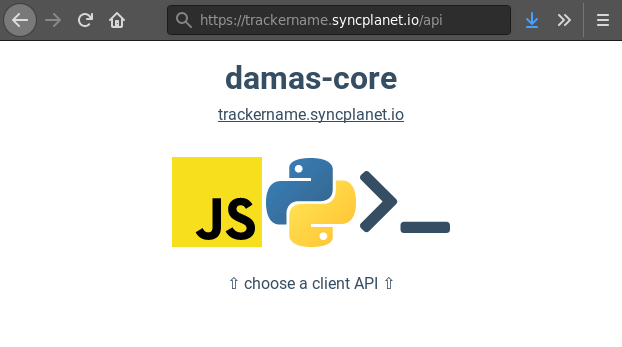
¶ Getting Started: Accessing the tracker API
The SyncPlanet service can be accessed by software developers using Python, Javascript and the command line interface. The API can be used:
- to configure the synchronization behavior, volumes, users,
- to publish files, read their synchronization states,
- to connect a content creation software such as Blender, Maya, Nuke using the Python language
- to connect to a production tracking software such as Shotgun, Ftrack, and extend its purpose.
Visit the API of your tracker using /api as path: https://yourtrackername.syncplanet.io/api. Choose your preferred languages and follow the guides to setup a development environment.
See the SyncPlanet API Reference for a complete function list. The tracker extends the damas-core engine which API is documented here: https://github.com/remyla/damas-core/wiki/3-API-reference .
¶ Setup a Python environment
Install the requests module. With pip:
pipenv install requests
Or with Debian:
apt install python-requests
Then import the damas-core Python module from your tracker https://yourtrackername.syncplanet.io/py/damas.py and connect to it:
Python 2.7.13 (default, Sep 26 2018, 18:42:22)
[GCC 6.3.0 20170516] on linux2
Type "help", "copyright", "credits" or "license" for more information.
# load the module
import damas
# connect to this server
project = damas.http_connection("https:://yourtrackername.syncplanet.io")
# list every node identifiers
project.search("*")
# read every nodes
project.read(project.search("*"))
# publish files
project.publish({
"_id": "/project/path/new_file",
"comment": "text",
"origin": "sitename"
})
¶ Publishing files
As soon as you set up a scripting environment, publishing new files to be synchronized may be the next step you need to do. Here is the reference for the publish method. Many options can be passed at publish time to control the way the file will be synchronized:
- You can define packages of folders to be synchronized: Packages
- You can control which volumes will be delivered: Destination-Filtering
The tracker and the synchronization agents behaviors can be configured according to your needs, therefore we recommend to read the available documentation.
¶ Scripting from the Javascript console

¶ Accessing result
The identifiers of the elements shown in a search result are available in the results global variable. Therefore, to process the 296 elements shown in the example screen shot and remove the error on each file:
damas.update({_id: results, sync_error:null });
¶ Scripting from the command line and Bash

The guide to use the command line interface is available on your tracker:
https://yourtrackername.syncplanet.io/cli
Here is the man page:
NAME
damas - a command line interface for digital asset management
SYNOPSIS
damas [OPTION...] <command> [<args>]
damas [--help] [-q|--quiet] [-v|--verbose] [-l|--lines] <command> [<args>]
DESCRIPTION
curl-based command to expose the operations of a damas-core service and manage a local repository filesystem
COMMANDS
File commands:
add Add files to the index
init Prepare the current directory adding a .damas/ repo folder
lock Lock files (set key 'lock' = user name)
rm Remove files from the index
show Show files record
signin <username> <pass>
signout Remove authorization token
stats Update file_mtime and file_size keys of files
unlock Unlock files
CRUDS commands (send JSON to the server, see examples below):
create <json> create node(s)
read <json> show the keys of the file
update <json> update nodes
delete <json> delete nodes
search <query> search
search_mongo <query> <sort> <limit> <skip> MongoDB search
ENVIRONMENT VARIABLES
DAMAS_DIR
Path to the repository. It can be an absolute path or relative path to current working directory.
DAMAS_SERVER
URL of the server hosting damas-core. It can specify `https://` or `http://` protocols.
DAMAS_TOKEN
Token used for authentication.
EXAMPLES
start tracking every files in current directory
damas add *
create an arbitrary node giving a JSON
damas create '{\"#parent\":\"value\",\"comment\":\"created with cli\"}'
read nodes for every file in the current directory
damas show *
search keys matching a regular expression
damas search _id:/.*mov/
search deleted:true key, sort by _id key, show result as lines of ids
damas -l search_mongo '{"deleted":true}' '{"_id":1}' 0 0
EXIT VALUES
0 Success
1 Syntax or usage error
2 Not a damas repository (or any parent)
3 Server is unreachable
7 (Server 207) Multi-Status (some nodes do not exist)
40 (Server 400) Bad request (not formatted correctly)
41 (Server 401) Unauthorized
43 (Server 403) Forbidden (the user does not have the right permission)
44 (Server 404) Not found (all the nodes do not exist)
49 (Server 409) Conflict (all nodes already exist with these identifiers)
50 (Server 500) Internal server error
60 (Server xxx) Unknown server error
FILES
.damas/config in repository root
CREDITS
damas.sh part of damas-core and is distributed under the GNU General Public License.
See the file LICENSE for details.
AUTHOR
damas.sh was originally written by Thibault Allard and is maintained by Remy Lalanne.
This command can be integrated in your Shell scripts to build more complex tools and add the synchronization aspect in your pipeline.
¶ [FR] Écouteur d'évènements
Pour "écouter" les modifications sur le tracker SyncPlanet:
¶ Solution A - search / toutes les 10 secondes
Rechercher les 500 derniers élements qui ont été synchronisés:
project.search_mongo(
{ "synced_inthebox": {"$exists": True},
"synced_jungler": {"$exists": True},
"synced_moondog": {"$exists": True}},
{"time":-1}, 500, 0)
On obtient un tableau contenant les chemins vers les fichiers. https://github.com/remyla/damas-core/wiki/3-API-reference#search_mongo
¶ Solution B - WebSockets
https://github.com/remyla/damas-core/wiki/Event-API Pas encore utilisé en production. On se connecte au serveur via son port websocket (socket.io) et on reçoit les évènements de modification en push. Exemple d'ouverture d'un client: https://github.com/remyla/damas-core/blob/master/js/damas-socket.js et un fichier d'exemple en JS https://bluezoo.syncplanet.io/socket-demo.html (à remettre en fonction de mon coté si on utilise. Socketio existe dans beaucoup de langages dont Python)
Nous aiderons pour la mise en place. La solution A est assez simple à mettre en oeuvre, la solution B un peu moins mais les notifications en push sont appréciables